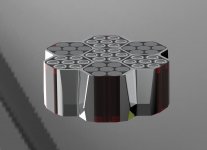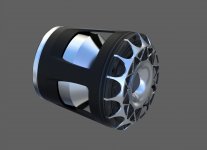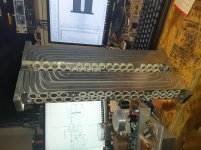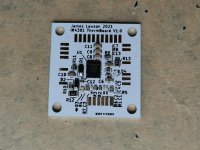Hi there
Using NX NASTRAN for the FEA. Optimised for modal response and minimising external panel deflection in the <400Hz range with global positive / negative volumetric pressures . Above that range I'm hoping there should be enough damping to take care of any spurious bits of energy. And the bracing will get exponentially ridiculous to chase the increasingly inaccurate higher modes.
Doing the "knuckle rap" test is very impressive to me, high pitch with fast decay. A long way from many commercial PA / Hifi cabinets!
That's a serious pack! (Is that a Keyshot render?). How do the cells fit in, and why the shape? Does it interface with other parts?
Using NX NASTRAN for the FEA. Optimised for modal response and minimising external panel deflection in the <400Hz range with global positive / negative volumetric pressures . Above that range I'm hoping there should be enough damping to take care of any spurious bits of energy. And the bracing will get exponentially ridiculous to chase the increasingly inaccurate higher modes.
Doing the "knuckle rap" test is very impressive to me, high pitch with fast decay. A long way from many commercial PA / Hifi cabinets!
That's a serious pack! (Is that a Keyshot render?). How do the cells fit in, and why the shape? Does it interface with other parts?
Update!
Been pulled away from projects over the last couple of months, so progress has been slower than I'd like. Also the electronics has been a PITA to get correct. Many revisions to get the noise out of it, reducing idle losses and the switching between power supplies working well. The final schematic is shown below with the images
Need to fix some of the staining now, before I set the PU over the top. 18mm chamfers have worked really well visually I think, and also help to maximise the volume for the given circumference.
Then *finally* I'll be able to use it!
Been pulled away from projects over the last couple of months, so progress has been slower than I'd like. Also the electronics has been a PITA to get correct. Many revisions to get the noise out of it, reducing idle losses and the switching between power supplies working well. The final schematic is shown below with the images
Need to fix some of the staining now, before I set the PU over the top. 18mm chamfers have worked really well visually I think, and also help to maximise the volume for the given circumference.
Then *finally* I'll be able to use it!
Attachments
-
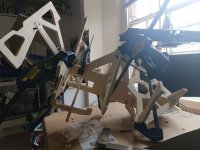 DSC_0267.jpeg152.6 KB · Views: 375
DSC_0267.jpeg152.6 KB · Views: 375 -
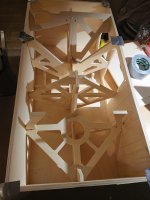 DSC_0272.jpeg233.1 KB · Views: 357
DSC_0272.jpeg233.1 KB · Views: 357 -
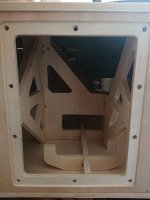 DSC_0275.jpeg204.9 KB · Views: 361
DSC_0275.jpeg204.9 KB · Views: 361 -
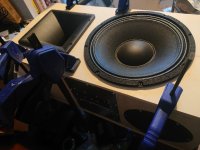 DSC_0281.jpeg151.8 KB · Views: 358
DSC_0281.jpeg151.8 KB · Views: 358 -
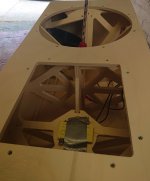 DSC_0529.jpeg192.3 KB · Views: 348
DSC_0529.jpeg192.3 KB · Views: 348 -
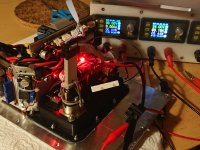 DSC_0346.jpeg200.2 KB · Views: 272
DSC_0346.jpeg200.2 KB · Views: 272 -
 Screenshot 2021-06-30 at 22.02.04.png247.7 KB · Views: 274
Screenshot 2021-06-30 at 22.02.04.png247.7 KB · Views: 274 -
 DSC_0528.jpeg135.2 KB · Views: 260
DSC_0528.jpeg135.2 KB · Views: 260
That brace is full jet fighter! Looking very good; excellent work for sure. Nastran definitely takes modeling to the highest degree. So I'm guessing you used negative pressure to look at the bracing under buckle to chase down waste? I wish I could do some advanced sims but I'm using LISA FEA which is bare bones and dealing with a complex mesh is almost unbearable. So I'll mostly fire it up to do AB comparisons for displacement and von Mises with dumbed down geometries.
On the battery stuff, that's correct, I'm in the Solidworks/HSM and Keyshot world. The current design is really just an evolution from many many designs, probably in the hundreds at this point. If you cluster the parallel cells and group them you can more easily manage routing. The main problem with packs is always the need to have separate wiring for the bms, so that's usually the biggest headache with layout. In this case the cells just drop in like they would with any regular "Energizer" type gadget. There is a similar top plate that provides connectivity, but in this case everything is very beefy, 1/8" copper plate with special wave-disc springs that put 5-10lbs of pressure on each cell ( through the floating plates) which have a 45deg. annular contact surface. It happens to be a round pack because I'm hashing out ways to do an integration with the Purifi driver; so, Purifi coax with the crossover, TCP3255, and battery. That's not a sure thing, but I just keep moving backing and forth on different utilities, integrating them a little more each time. The last pack I started on IRL was last year, a 1U rack mount 8s8p. It took almost a year of very intermittent tests to get the drilling operation perfected, but then there were still the dreaded routing issues to deal with, so I'm still working out those challenges and also doing things that will make construction easier.
Anyway, can't wait to find out how the backpack challenge performs!
On the battery stuff, that's correct, I'm in the Solidworks/HSM and Keyshot world. The current design is really just an evolution from many many designs, probably in the hundreds at this point. If you cluster the parallel cells and group them you can more easily manage routing. The main problem with packs is always the need to have separate wiring for the bms, so that's usually the biggest headache with layout. In this case the cells just drop in like they would with any regular "Energizer" type gadget. There is a similar top plate that provides connectivity, but in this case everything is very beefy, 1/8" copper plate with special wave-disc springs that put 5-10lbs of pressure on each cell ( through the floating plates) which have a 45deg. annular contact surface. It happens to be a round pack because I'm hashing out ways to do an integration with the Purifi driver; so, Purifi coax with the crossover, TCP3255, and battery. That's not a sure thing, but I just keep moving backing and forth on different utilities, integrating them a little more each time. The last pack I started on IRL was last year, a 1U rack mount 8s8p. It took almost a year of very intermittent tests to get the drilling operation perfected, but then there were still the dreaded routing issues to deal with, so I'm still working out those challenges and also doing things that will make construction easier.
Anyway, can't wait to find out how the backpack challenge performs!
Attachments
Pretty advanced stuff! box progress looks great, is the 20V buck for some kind of low power mode for the TPA3255? (but on the diagram the DSP is shown unpowered in this configuration?)
I'm very keen for the wider adoption of battery powered sound and although I had no trouble constructing my own pack it seems like it would be too much for the casual user so this pack idea seems to have a lot of utility.
I've been doing consultancy for months taking up my time. I hope to have a test board for my ir4301 bridge amps on aluboard soon which should approach 500W 4ohm capability to have a higher power/more efficent option than the TPA3255 (IR4301 has significantly lower Rds Fets).
I'm very keen for the wider adoption of battery powered sound and although I had no trouble constructing my own pack it seems like it would be too much for the casual user so this pack idea seems to have a lot of utility.
I've been doing consultancy for months taking up my time. I hope to have a test board for my ir4301 bridge amps on aluboard soon which should approach 500W 4ohm capability to have a higher power/more efficent option than the TPA3255 (IR4301 has significantly lower Rds Fets).
@haze head
Funny you say that - my day job is working on this!
Yeah, exactly. You can see some extra little braces added in to help with buckling. The process was incredibly iterative, I think I ran maybe 60 cases. Each time adding or removing mass to increase stiffness or take it out where it wasn't contributing - until I realised I was spending far too long on it lol (I should really learn their structural optimisation tool). The NX/NASTRAN workflow is very fast when setup, and their meshers and solvers are generally very reliable (so long as your models are good..)
What's your intent with the overall design with the Purifi? I'm intrigued as it seems to be hugely power (and mass) dense. I'm always intrigued by battery designs, I think there's something very pleasant about the arraying and inherent compact nature. I like a good busbar or two..
@kipman
Cheers! Yeah, the 20V buck is for the low power (5W system idle power) mode. The high power is about 15W, so limits the battery life a bit. Currently at high power it looks to last 6-12hrs, and the low power is around 24-48(!) hours.
The DSP is actually connected, as the current reverses up from the amp to the "off" section of the DPDT switch. I have lost the ability to automatically switch the fan when in the high power mode though, still trying to figure out how I can do that in a nooby way..
Yeah, consulting is a total time suck (even if the pay is great). Ended that last year and went into a comfy full time role to have a bit more free time.
Looking forwards to this little board. Would mean the battery could run at full voltage and I wouldn't have to worry about frying the poor TPA3255! Pushing the datasheet a bit with the Vsupply.
Funny you say that - my day job is working on this!
Yeah, exactly. You can see some extra little braces added in to help with buckling. The process was incredibly iterative, I think I ran maybe 60 cases. Each time adding or removing mass to increase stiffness or take it out where it wasn't contributing - until I realised I was spending far too long on it lol (I should really learn their structural optimisation tool). The NX/NASTRAN workflow is very fast when setup, and their meshers and solvers are generally very reliable (so long as your models are good..)
What's your intent with the overall design with the Purifi? I'm intrigued as it seems to be hugely power (and mass) dense. I'm always intrigued by battery designs, I think there's something very pleasant about the arraying and inherent compact nature. I like a good busbar or two..
@kipman
Cheers! Yeah, the 20V buck is for the low power (5W system idle power) mode. The high power is about 15W, so limits the battery life a bit. Currently at high power it looks to last 6-12hrs, and the low power is around 24-48(!) hours.
The DSP is actually connected, as the current reverses up from the amp to the "off" section of the DPDT switch. I have lost the ability to automatically switch the fan when in the high power mode though, still trying to figure out how I can do that in a nooby way..
Yeah, consulting is a total time suck (even if the pay is great). Ended that last year and went into a comfy full time role to have a bit more free time.
Looking forwards to this little board. Would mean the battery could run at full voltage and I wouldn't have to worry about frying the poor TPA3255! Pushing the datasheet a bit with the Vsupply.
Just finished the schematics for the IR4301 demo board and have 10 of the aluminum boards already. Ultimate idea is 8 channels of DSP (sigma studio) and 16 of these aluboards that mount using a cutout and castellated pads. Will do a single channel amp board (possibly just this demo board if it works well) as well. All schematics layouts etc. will be given away even if I'm selling finished boards as my objective is the proliferation of battery sound.
Attachments
@zerokelvin99
You know what, I'm not even slightly surprised lol. The fingerprints of aerospace are all too recognizable. I used to build Trent 800s at GKN and got to fool around with some of the JSF 'lifter fan' proto stuff as well. It's like once you're in that world you begin to see everything in those terms. Everything would be isogrid if I had my way 😀
As for the Purifi, it's mainly just that I'm new to high-end diy audio and I got into the Purifi as a sort of insurance that if whatever I wind up doing fails, it cannot be blamed on the gear. Basically-- I know that the PTT can perform, so if my build sucks, it's all on me; no need to waste time questioning my purchase. But more specifically to your comment on density, yes, it certainly doesn't spec. well for the backpack challenge. I still think it's a good fit for my goals though, which are more akin to 'portable off-grid hi-fi.' Meaning I'm wanting to do something that is more meant to be reasonably portable, like moving to a cabin in the deep woods and leaving it there. Not so much pack in, pack out every time. But ultimately I'm hoping to get the highest possible fidelity with the fewest parts, and it does appear to fit the bill there.
@kipman725
Your DSP project is really interesting and I'm obviously onboard with your sentiments about using battery power. Question; the DSP, can it be used in place of a passive crossover? I'm not there yet, but I'm interested in doing the PTT in a coax tweeter configuration and the obvious flaw there is the timing, but I'm curious can that get solved with what you are developing?
@philpope
"have you considered making the back and sides out of curved laminated ply to increase sitffness?" It's looking very likely that I'll be going with this technique as I'm hoping to use minimal bracing, so hopefully I can pull it off. There are some very attractive things about that strategy IMO.
You know what, I'm not even slightly surprised lol. The fingerprints of aerospace are all too recognizable. I used to build Trent 800s at GKN and got to fool around with some of the JSF 'lifter fan' proto stuff as well. It's like once you're in that world you begin to see everything in those terms. Everything would be isogrid if I had my way 😀
As for the Purifi, it's mainly just that I'm new to high-end diy audio and I got into the Purifi as a sort of insurance that if whatever I wind up doing fails, it cannot be blamed on the gear. Basically-- I know that the PTT can perform, so if my build sucks, it's all on me; no need to waste time questioning my purchase. But more specifically to your comment on density, yes, it certainly doesn't spec. well for the backpack challenge. I still think it's a good fit for my goals though, which are more akin to 'portable off-grid hi-fi.' Meaning I'm wanting to do something that is more meant to be reasonably portable, like moving to a cabin in the deep woods and leaving it there. Not so much pack in, pack out every time. But ultimately I'm hoping to get the highest possible fidelity with the fewest parts, and it does appear to fit the bill there.
@kipman725
Your DSP project is really interesting and I'm obviously onboard with your sentiments about using battery power. Question; the DSP, can it be used in place of a passive crossover? I'm not there yet, but I'm interested in doing the PTT in a coax tweeter configuration and the obvious flaw there is the timing, but I'm curious can that get solved with what you are developing?
@philpope
"have you considered making the back and sides out of curved laminated ply to increase sitffness?" It's looking very likely that I'll be going with this technique as I'm hoping to use minimal bracing, so hopefully I can pull it off. There are some very attractive things about that strategy IMO.
Last edited:
@Haze head
yep fully replaces passive crossovers. I was planning on using the ADAU1467WBCPZ300 DSP which is one of the largest and highest spec sigma DSPs: SigmaStudio Toolbox [Analog Devices Wiki] along with a AD1937WBSTZ audio codec. I'm currently using one of these: ADAU1701-2In4Out | 3e Audio with an additional DAC to perform a 2 in 6 out crossover.
yep fully replaces passive crossovers. I was planning on using the ADAU1467WBCPZ300 DSP which is one of the largest and highest spec sigma DSPs: SigmaStudio Toolbox [Analog Devices Wiki] along with a AD1937WBSTZ audio codec. I'm currently using one of these: ADAU1701-2In4Out | 3e Audio with an additional DAC to perform a 2 in 6 out crossover.
Ah, nice! I'll have to read up on this. Am having trouble picturing how the interface works. Presumably there is a way to make adjustments, even on the fly perhaps.
The design is a flow graph that is 'compiled' and download to the DSP but the blocks that make up the flow graph can have adjustable values (EG. Gain, frequency point) that are live adjustable. There are also things like level meters that will display live values. Its a bit clunky compared to pro audio DSPs but with enough effort you can get the same results. I think the Sigma DSPs are pretty great as the alternative is a lot of boring programing on something like a Sharc or an FPGA which would take a lot of time.
About FPGA, I hear that; oof.
It looks like the interface is perfect to maybe run with an ESP32 via cell phone. I see it's been successfully used to do noise cancelling BTW!
It looks like the interface is perfect to maybe run with an ESP32 via cell phone. I see it's been successfully used to do noise cancelling BTW!
another paper about increasing effective enclosure volume using various materials:
https://pubs.acs.org/doi/pdf/10.1021/acsami.9b07965?rand=fexpt29v&
possibly the use of powders is faff/weight but I notice that the melamine foam alone still results in an enclosure effective volume increase of ~12% (and the authors have not filled the full enclosure with the foam).
https://pubs.acs.org/doi/pdf/10.1021/acsami.9b07965?rand=fexpt29v&
possibly the use of powders is faff/weight but I notice that the melamine foam alone still results in an enclosure effective volume increase of ~12% (and the authors have not filled the full enclosure with the foam).
kipman725,
Link didn't work for me.
The enclosure effective volume increases using fill I've seen are measured using sealed cabinets, while stuffing ported cabinets reduces output.
Was the melamine foam used on a ported cabinet?
Art
Link didn't work for me.
The enclosure effective volume increases using fill I've seen are measured using sealed cabinets, while stuffing ported cabinets reduces output.
Was the melamine foam used on a ported cabinet?
Art
My apologies weltersys, I was inadvertently accessing the paper from a location with a library subscription. I have found what looks to be a preprint here:
Virtual loudspeaker effect of graphene-based hybrid material to improve low frequency acoustic performance | Kim, Ji Hoon; Lim, Sun Taek; Shim, Gyu Hyun; Lee, Gil Won; Kim, Sungjoo; Kim, Namkeun; Wongwises, Somchai; Ahn, Ho Seon | download
There does seem to be a reduction in the impedance peak magnitudes which I think would also mean for a ported cabinet output would be reduced from the port. This would also be consistent with these results:
Data-Bass: Subwoofer Measurements
For a sealed cab I have also observed that heavy stuffing can reduce the impedance peak to the point the resonance is barley visible which will result in reduced overall system efficiency. I presume though the extra heating is in the stuffing and not in the driver?
Virtual loudspeaker effect of graphene-based hybrid material to improve low frequency acoustic performance | Kim, Ji Hoon; Lim, Sun Taek; Shim, Gyu Hyun; Lee, Gil Won; Kim, Sungjoo; Kim, Namkeun; Wongwises, Somchai; Ahn, Ho Seon | download
There does seem to be a reduction in the impedance peak magnitudes which I think would also mean for a ported cabinet output would be reduced from the port. This would also be consistent with these results:
Data-Bass: Subwoofer Measurements
For a sealed cab I have also observed that heavy stuffing can reduce the impedance peak to the point the resonance is barley visible which will result in reduced overall system efficiency. I presume though the extra heating is in the stuffing and not in the driver?
The more heat retained within the cabinet, the less it is exchanged to the outside air.For a sealed cab I have also observed that heavy stuffing can reduce the impedance peak to the point the resonance is barley visible which will result in reduced overall system efficiency. I presume though the extra heating is in the stuffing and not in the driver?
If overall system efficiency is lost, to achieve the same sound pressure level would require higher input voltage, which will cause the voice coil to heat up more, rise in impedance, requiring even more voltage.
Yes I agree but in the heavier stuffing case I observed the impedance magnitude had reduced around resonance so it's not that more volts are needed but that the same voltage is causing a larger current.
Post summer update
All,
Good chat above!
Been a while since I've posted. Managed to finish the 'box and it's been out a fair bit in the Welsh countryside, house parties, etc. Aesthetically it’s definitely on the crude side though, and won’t win any beauty awards.
Sonically, happy with how it (eventually) turned out. With enough iterations of the DSP, the sound is well balanced across the board. Quite directional still, but really does sound “full” outdoors and bigger than it is. Of course, not on the scale of a larger PA, but it does drop down flat to 50Hz now, and can really thump out at enough volume for my / our needs. The integration between the 12” and the 1” seems really nice, with a wide response sweet spot around 10-50deg off axis.
The ‘box targets drum and bass at medium SPL, but also drops low enough (with additional EQ wound in) for dub or more bassline dependant genres. It also seems happy with techno & house, with the 12” tight enough for the faster impulses. Less intensive genres such as jazz or vocal also work well. There are some issues with sibilance and harshness with female vocals in the upper ranges, I think that’s mainly down to my handling of the CD horn in indoor vs. outdoor spaces. To be worked on one day. The 105mm (50hz tuned) port is based on an elliptical profile has been noiseless, even with a theoretical peak velocity of 33 m/s.
The power systems work really well. It has two internal rail options - direct from battery at 54V peak (48V nominal) or through a buck to supply the amplifier at 20V. I have rinsed it in both and the tradeoff between power or battery is invaluable. In most scenarios the 20V is more than enough, giving plenty of ‘tactility’ and SPL within a 5m radius. Above that, or if you would rather dance than talk, then the 54v (48V nominal) gives another 9dB or so, but with twice the idle power draw plus the extra power to the woofer.
The battery life is around 10-14 hours for full tilt @ 48V rail, or around 40-60 hours for the 20V rail (estimated, never made it that far yet). The battery was swapped to a 13S2P 21700 pack, which at 420Ah is really overkill. Although, voltage drop is a non-issue - with the maximum average draw being around 60w (no clip) or 120w (into clip, but audibly OK) at 54V.
The psychoacoustics module is one that I haven’t figured out a happy place yet. I have it set up to increase harmonics 35-55Hz, giving more “weight” in that band. Sometimes this works great (especially given that dropping below 50Hz in half space is tough for this), but it can sneak into the audible distortion area with some tracks. Disco seems to be a problem particularly - no idea why yet.
The electronics has continually and painfully evolved over time (my electronics generally follows a “figure it out as you go” attitude). Below is the latest ‘schematic’, the only real outstanding issue is that the OLED power monitor keeps on blowing its XL7005 driver (?). The MOSTFET soft-start circuits I built are going well though, and stops the switches welding themselves together after <50 cycles. The fan keeps inductors and chip temps in line, and only kicks in with the 48V mode (where it’s on all the time).
Probably due some TLC over the winter. Looking to fit a proper recessed wooden baffle and replace the PITA power meter with a better solution. LEDS from the GPIO pins seems sensible. Maybe also take 50mm off the height of it too if I find the time.
..And also a clean 😀





All,
Good chat above!
Been a while since I've posted. Managed to finish the 'box and it's been out a fair bit in the Welsh countryside, house parties, etc. Aesthetically it’s definitely on the crude side though, and won’t win any beauty awards.
Sonically, happy with how it (eventually) turned out. With enough iterations of the DSP, the sound is well balanced across the board. Quite directional still, but really does sound “full” outdoors and bigger than it is. Of course, not on the scale of a larger PA, but it does drop down flat to 50Hz now, and can really thump out at enough volume for my / our needs. The integration between the 12” and the 1” seems really nice, with a wide response sweet spot around 10-50deg off axis.
The ‘box targets drum and bass at medium SPL, but also drops low enough (with additional EQ wound in) for dub or more bassline dependant genres. It also seems happy with techno & house, with the 12” tight enough for the faster impulses. Less intensive genres such as jazz or vocal also work well. There are some issues with sibilance and harshness with female vocals in the upper ranges, I think that’s mainly down to my handling of the CD horn in indoor vs. outdoor spaces. To be worked on one day. The 105mm (50hz tuned) port is based on an elliptical profile has been noiseless, even with a theoretical peak velocity of 33 m/s.
The power systems work really well. It has two internal rail options - direct from battery at 54V peak (48V nominal) or through a buck to supply the amplifier at 20V. I have rinsed it in both and the tradeoff between power or battery is invaluable. In most scenarios the 20V is more than enough, giving plenty of ‘tactility’ and SPL within a 5m radius. Above that, or if you would rather dance than talk, then the 54v (48V nominal) gives another 9dB or so, but with twice the idle power draw plus the extra power to the woofer.
The battery life is around 10-14 hours for full tilt @ 48V rail, or around 40-60 hours for the 20V rail (estimated, never made it that far yet). The battery was swapped to a 13S2P 21700 pack, which at 420Ah is really overkill. Although, voltage drop is a non-issue - with the maximum average draw being around 60w (no clip) or 120w (into clip, but audibly OK) at 54V.
The psychoacoustics module is one that I haven’t figured out a happy place yet. I have it set up to increase harmonics 35-55Hz, giving more “weight” in that band. Sometimes this works great (especially given that dropping below 50Hz in half space is tough for this), but it can sneak into the audible distortion area with some tracks. Disco seems to be a problem particularly - no idea why yet.
The electronics has continually and painfully evolved over time (my electronics generally follows a “figure it out as you go” attitude). Below is the latest ‘schematic’, the only real outstanding issue is that the OLED power monitor keeps on blowing its XL7005 driver (?). The MOSTFET soft-start circuits I built are going well though, and stops the switches welding themselves together after <50 cycles. The fan keeps inductors and chip temps in line, and only kicks in with the 48V mode (where it’s on all the time).
Probably due some TLC over the winter. Looking to fit a proper recessed wooden baffle and replace the PITA power meter with a better solution. LEDS from the GPIO pins seems sensible. Maybe also take 50mm off the height of it too if I find the time.
..And also a clean 😀





Battleship Gray, looks cool! Surprised the cone hasn't been torn with no protection.The ‘box targets drum and bass at medium SPL, but also drops low enough (with additional EQ wound in) for dub or more bassline dependant genres. It also seems happy with techno & house, with the 12” tight enough for the faster impulses. The 105mm (50hz tuned) port is based on an elliptical profile has been noiseless, even with a theoretical peak velocity of 33 m/s.
The psychoacoustics module is one that I haven’t figured out a happy place yet. I have it set up to increase harmonics 35-55Hz, giving more “weight” in that band. Sometimes this works great (especially given that dropping below 50Hz in half space is tough for this), but it can sneak into the audible distortion area with some tracks. Disco seems to be a problem particularly - no idea why yet.
Not clear what the psychoacoustics module is doing- if you are using it to create increased output level below Fb, that should distort badly, wouldn't take much to exceed Xmax and make vocals and upper instruments "gargle" with amplitude modulation with each low note or kick. The module can probably create enough low bass output to completely counteract a BW24 HP filter which should be set only a few Hz below Fb.
Most classic "disco" from the vinyl era had little below 50 Hz to start with, so adding that distortion would be even more problematic- it wouldn't have happened with most speakers.
To get the impression of more low bass, most psycho-acoustics modules (like MaxxBass, etc.) add or increase even order harmonics of the fundamental, 25 Hz adds 50/100 Hz, 40hz adds 80/160 Hz.
If the music depends on the bass, instead of the bass line dropping out below Fb, you still hear the missing bass notes in the "enhanced" harmonic intervals of the fundamentals, even if the fundamental notes are completely eliminated.
Still won't flap your trouser legs, but nobody really needs that to dance ;^)
Anyway, good to hear it all came together, impressive battery life and output!
Cheers,
Art
For classic disco you want a sub harmonic synth (I think DBX 100 is the classic model?). Not applicable here though as your speaker can't go low enough. I wouldn't use something that took away the fundamentals and added harmonics.
Protection/grills for speakers are always a total pain, sheet metal is expensive, vibrates and is heavy. Perhaps you could get away with some kind of metal arches over the cone so that its protected from larger objects and rubbing.
Regarding the sibalence issues it sounds like the EQ is wrong in some way, do you have any measurements? also if your playing music loudly you probably want a cut around 2.6kHz to remove harshness.
Protection/grills for speakers are always a total pain, sheet metal is expensive, vibrates and is heavy. Perhaps you could get away with some kind of metal arches over the cone so that its protected from larger objects and rubbing.
Regarding the sibalence issues it sounds like the EQ is wrong in some way, do you have any measurements? also if your playing music loudly you probably want a cut around 2.6kHz to remove harshness.
- Home
- Live Sound
- PA Systems
- Backpack challenge
